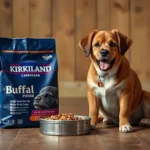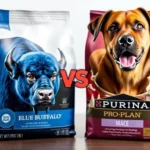
Introduction
Dog nutrition plays a crucial role in ensuring our furry friends lead healthy, happy lives. Proper nutrition is linked to everything from energy levels to coat health, making it essential for dog owners to choose the right food. Among the many brands available on the market, Alpo dog food stands out as a popular choice for many pet parents. With a range of products designed to cater to various breeds and life stages, Alpo has made a name for itself in the pet food industry. In this comprehensive review, we will delve into the nutritional value, ingredient quality, and overall suitability of Alpo dog food for different dogs.
Understanding Dog Nutrition
Importance of Proper Nutrition for Dogs
Just like humans, dogs require a balanced diet to thrive. Proper nutrition is vital for maintaining a healthy weight, supporting immune function, and promoting overall well-being. A diet lacking in essential nutrients can lead to a myriad of health issues, including obesity, dental problems, and even chronic diseases.
Key Nutritional Components
-
Proteins: The building blocks of your dog’s body, proteins are crucial for muscle development, tissue repair, and immune function. Quality protein sources include chicken, beef, and fish.
-
Fats: Essential for energy and skin health, fats also play a role in the absorption of fat-soluble vitamins. Healthy fats, such as omega-3 and omega-6 fatty acids, contribute to a shiny coat and healthy skin.
-
Carbohydrates: While dogs are primarily carnivorous, carbohydrates provide a quick energy source and aid in digestion as they contain fiber. Ingredients like brown rice and sweet potatoes are excellent sources of healthy carbs.
-
Vitamins and Minerals: These micronutrients are essential for a variety of bodily functions, including bone health and immune system support. Key vitamins include A, D, E, and B-complex, while minerals like calcium and phosphorus are vital for strong bones.
Overview of Alpo Dog Food
Brand History
Alpo was established in the 1930s and has become synonymous with affordable and accessible dog food. Originally created by the Alpo Company, it was acquired by Nestlé Purina PetCare in 1984. Over the years, Alpo has built a reputation for producing a range of dog food products that cater to various dietary needs and preferences.
Product Range
Alpo offers a diverse selection of dog food, including:
- Wet food: Canned varieties that are rich in moisture and flavor.
- Dry food: Kibble options that are convenient and often more economical.
- Treats: Snacks that can be used for training or as rewards.
The brand also features a variety of flavors and formulations, including beef, chicken, and lamb, ensuring there are options to suit most dogs’ tastes.
Ingredient Analysis of Alpo Dog Food
Key Ingredients
Alpo dog food products generally contain a mix of meat, grains, and fillers. Common ingredients found in Alpo products include:
- Meat and meat by-products: The primary source of protein in many Alpo recipes. While meat by-products can be controversial, they are often rich in essential nutrients.
- Grains: Ingredients like corn and wheat are commonly found in Alpo’s dry food options. While grains can provide energy and fiber, some dog owners prefer grain-free diets.
- Fillers: Ingredients that may not offer significant nutritional value, such as corn gluten meal, are often used to bulk up the food.
Nutritional Content
Alpo dog food typically provides the following guaranteed analysis:
- Protein: Varies by product but generally ranges from 18% to 30%.
- Fat: Usually between 8% and 20%.
- Fiber: Typically around 3% to 6%.
- Moisture: Canned products may contain up to 78% moisture.
This nutritional content provides a solid foundation for a dog’s diet, but it’s essential to compare the specifics across different Alpo products to find the right fit for your dog.
Quality of Ingredients
The quality of ingredients in Alpo dog food can vary. While some products contain high-quality protein and nutritious grains, others may include lower-quality fillers and artificial additives. It’s essential for dog owners to read labels carefully and understand what they are feeding their pets. Some controversial ingredients to be aware of include:
- Meat by-products: While they can be nutritious, the source and quality can vary.
- Artificial colors and flavors: These can be unnecessary and may not contribute to a dog’s health.
Health Benefits and Risks
Potential Health Benefits
Alpo dog food can offer several health benefits, including:
- Omega fatty acids: Found in fish-based products, these can promote healthy skin and a shiny coat.
- Balanced nutrition: With a mix of protein, fats, and carbohydrates, Alpo can help meet the dietary needs of dogs of various sizes, ages, and activity levels.
Potential Health Risks
While there are benefits, there are also potential risks:
- Allergies: Some dogs may be allergic to specific ingredients, such as corn or wheat, which are prevalent in many Alpo products.
- Low-quality ingredients: Concerns about the use of fillers and meat by-products can lead to digestive issues or other health problems.
Customer Reviews and Feedback
General Customer Sentiment
Overall, customer sentiment regarding Alpo dog food is mixed. Many dog owners appreciate the affordability and variety of flavors, noting that their dogs enjoy the taste. However, some reviews highlight concerns about ingredient quality and potential digestive issues.
Case Studies
-
Positive Experience: One dog owner reported that their senior dog thrived on Alpo’s wet food, regaining energy and improving coat health.
-
Negative Experience: Another owner mentioned that their dog developed gastrointestinal issues after transitioning to Alpo, suggesting that ingredient sensitivity may have played a role.
Comparison with Other Dog Food Brands
Alpo vs. Competitors
When compared to other popular dog food brands such as Pedigree and Purina, Alpo tends to be more budget-friendly. However, the ingredient quality and nutritional value can vary significantly. For instance, many premium brands focus on whole meats and higher-quality grains, which can lead to better overall health outcomes for dogs.
Best Practices for Choosing Dog Food
When selecting dog food, consider the following tips:
- Read labels carefully: Look for high-quality protein sources and avoid products with excessive fillers.
- Consult with a veterinarian: Your vet can provide personalized recommendations based on your dog’s health, age, and activity level.
- Consider your dog’s preferences: Some dogs may have specific taste preferences that could influence their willingness to eat certain foods.
Conclusion
In conclusion, Alpo dog food offers a range of options that cater to various dog breeds and life stages. While it provides essential nutrients and is generally well-liked by dogs, potential risks associated with ingredient quality and allergies cannot be overlooked. As with any dog food, it’s crucial for pet owners to consider their dog’s specific needs and consult with a veterinarian to ensure they are providing the best nutrition possible.
FAQs
Common Questions About Alpo Dog Food
Is Alpo dog food good for all breeds?
Alpo offers a variety of formulations, making it suitable for many breeds, but it’s essential to choose the right product based on your dog’s specific needs.
How should I store Alpo dog food?
Always store dry food in a cool, dry place and keep wet food refrigerated after opening.
General Dog Nutrition Questions
Can dogs be vegetarian?
While dogs can thrive on a plant-based diet, it requires careful planning to ensure they receive all necessary nutrients. Consulting a veterinarian is highly recommended.
What are the signs of poor nutrition in dogs?
Common signs include dull coat, lethargy, weight fluctuations, and digestive issues. If you notice these signs, it may be time to reevaluate your dog’s diet.









